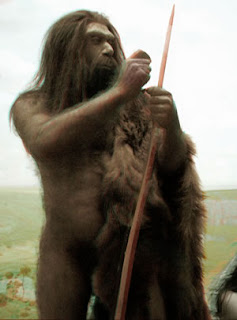 Does everyone but me realize that Neanderthals and humans are/were different species. I always thought that Neanderthals were humans alive a long time ago.
Does everyone but me realize that Neanderthals and humans are/were different species. I always thought that Neanderthals were humans alive a long time ago.But the news today that the two interbred over a 50,000 to 80,000 year period has me trying to thread back to what the differences between the two are. USA Today comments on the Science journal article saying, " Humans and Neanderthals likely interbred 50,000 to 80,000 years ago in the Near East, concludes the international genetics team's pair of studies."
So scouting around USA Today stories, I found a recent article that says, "In the Nature journal study, the pinky bone discovered in the Denisova cave archaeological site in southern Siberia yielded mitochondrial DNA — maternal genes inherited outside of the ones found in cell's chromosomes — unrelated to either humans or their extinct Neanderthal cousins."
Okay, this says Neanderthals were cousins to humans. We are getting somewhere. But now, this new article is telling me "although genetically distant from humans, the new species appears much more closely related to humans than apes." So there is another species.
Maybe I should refresh my memory on what "species"means. So, thank you Wikipedia, as always I can find a quick reference. It says, "There are many definitions of what kind of unit a species is (or should be). A common definition is that of a group of organisms capable of interbreeding and producing fertile offspring of both genders, and separated from other such groups with which interbreeding does not normally happen. Other debatable definitions may focus on similarity of DNA or morphology. Some species are further subdivided into subspecies, and here also there is no close agreement on the criteria to be used."
The San Francisco Chronicle has a good story pointing to the joining of DNA between modern humans and Neanderthals: "The sequencing of Neanderthal genetic material is real gold because we can now compare the Neanderthal genome with our own and pinpoint the genetic changes that have enabled humans to thrive, to spread across the entire globe, and to occupy every ecological niche that exists in the world," says Richard E. Green, about the Science report.
And: "The complete genomes of the Neanderthals and modern humans, whose lineages separated from some unknown common ancestor at least 400,000 years ago, are 99.5 percent identical. They are, in fact, our closest evolutionary relatives. By comparison, humans and chimpanzees share 98 percent of their genes."

